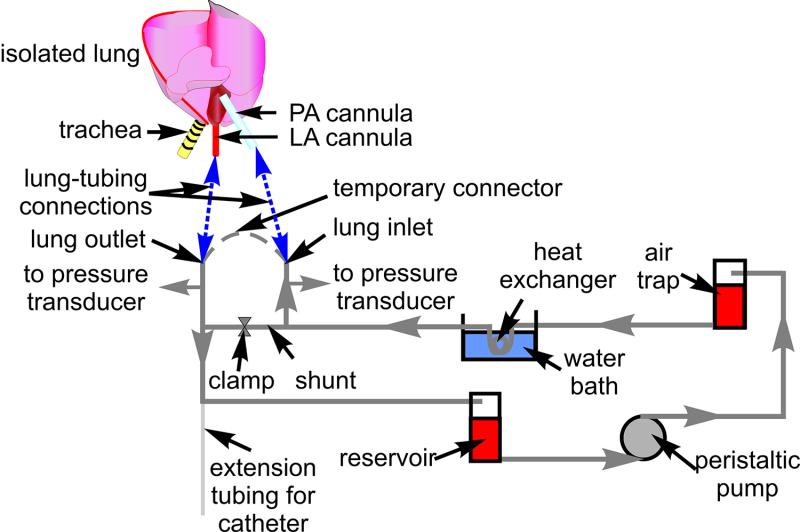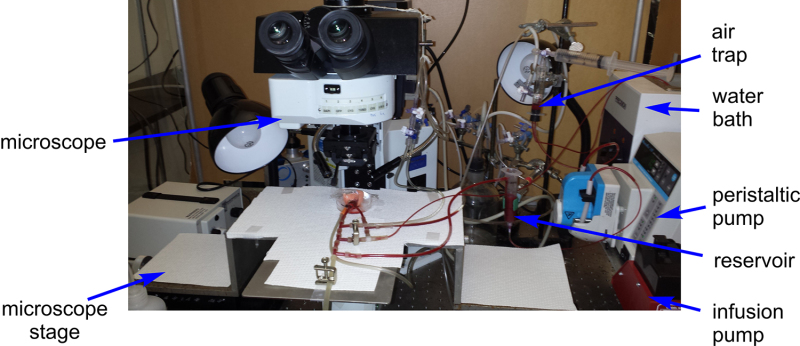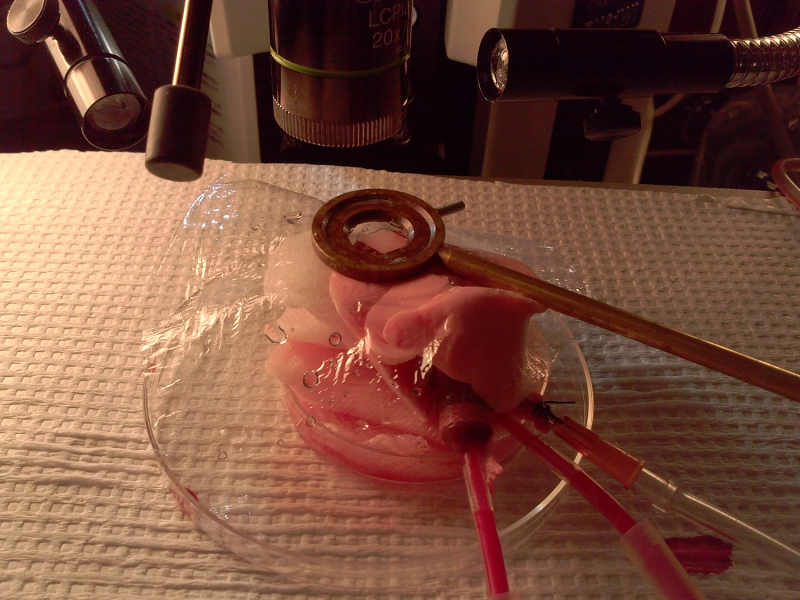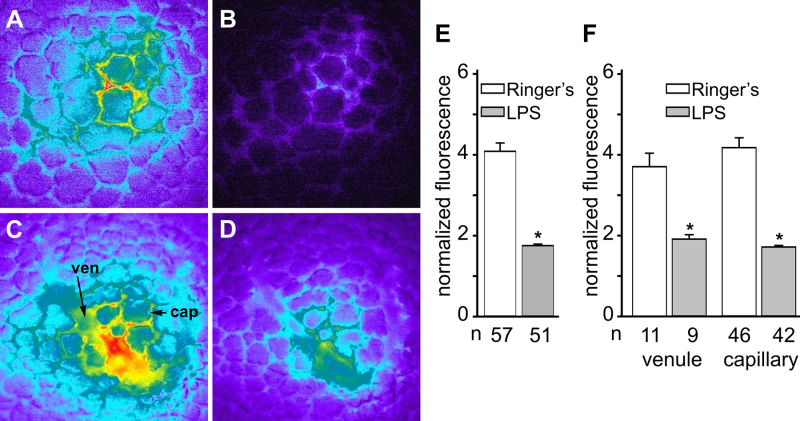Abstract
The isolated blood-perfused lung preparation is widely used to visualize and define signaling in single microvessels. By coupling this preparation with real time imaging, it becomes feasible to determine permeability changes in individual pulmonary microvessels. Herein we describe steps to isolate rat lungs and perfuse them with autologous blood. Then, we outline steps to infuse fluorophores or agents via a microcatheter into a small lung region. Using these procedures described, we determined permeability increases in rat lung microvessels in response to infusions of bacterial lipopolysaccharide. The data revealed that lipopolysaccharide increased fluid leak across both venular and capillary microvessel segments. Thus, this method makes it possible to compare permeability responses among vascular segments and thus, define any heterogeneity in the response. While commonly used methods to define lung permeability require postprocessing of lung tissue samples, the use of real time imaging obviates this requirement as evident from the present method. Thus, the isolated lung preparation combined with real time imaging offers several advantages over traditional methods to determine lung microvascular permeability, yet is a straightforward method to develop and implement.
Keywords: Anatomy, Issue 88, acute lung injury, capillaries, ex vivo lung preparation, FITC dextran, fluorescence microscopy, imaging, Metamorph, venule
Introduction
Increased microvascular permeability in lungs leads to development of alveolar edema and compromised gas exchange and is a major characteristic of acute lung injury (ALI)1-3. Thus, estimates of vascular permeability are important in defining the extent of lung injury and efficacy of proposed therapeutic interventions. Gravimetric analysis such as blood free lung wet-to-dry ratio and microvascular filtration coefficient are widely used methods to estimate permeability4,5. Other methods include quantifying the retention of radioactive or fluorescent probes in lung tissue6-8. However, the above methods require postexperiment processing of lung tissue samples toward elucidating the permeability data. Moreover, since one animal can be only used for a single treatment protocol, large animal numbers may be needed for a complete study. A common characteristic of the above methods is that they determine the mean vascular permeability for all blood vessels within the tissue sample. However, it is well established that pulmonary micro- and macro-vessels are phenotypically different9. Hence, permeability responses may be heterogeneous among the various vessel segments as well9,10. Thus, quantifying mean permeability of all pulmonary vessels in a tissue sample may not adequately reflect this heterogeneity.
In the isolated blood-perfused lung preparation, blood vessels on the lung surface can be visualized by an upright microscope4,11,12. This enables characterizing responses in single vessels and thus, addressing any heterogeneity in the responses13. In addition, by utilizing fluorescence imaging of microvessels, fluorescence based assays can be incorporated. Further, a left atrial microcatheter can be used to deliver agents and fluorescence probes into blood vessels11,14. The microcatheter limits the delivery to a small lung region, thus exposing only the blood vessels within the region to the infused agents and fluorophores. This allows multiple small regions within the same lung to be used for separate experiments, leading to an overall reduction in animals needed for a study.
Real time imaging enables capture of dynamic changes in vascular and extravascular fluorescence of single microvessels of the isolated lung preparation. Thus, for each microvessel within an image field, changes in fluorescence during infusion of fluorophores and washoff can be recorded, and quantified offline14. Using values of maximum and residual vascular fluorescence, a permeability index for each microvessel within the imaging field can be determined. To determine permeability changes in response to inflammatory or injurious agents, the desired agent can be administered first and then the permeability index determined. In addition, the image field can be set anywhere within the lung region infused by the microcatheter, thus enabling a high degree of flexibility in selecting the desired vascular network. Thus, the isolated blood-perfused lung preparation in tandem with real time imaging provides an attractive experimental model to quantify permeability in single lung microvessels.
Protocol
All experiments performed on animals were as approved by the Institutional Animal Care and Use Committee of the University of Tennessee Health Science Center.
1. Tubing for Perfusing Rat Lung Preparations
Prepare a tubing system with Tygon tubing (#18) for blood perfusion as shown in Figure 1. Connect pressure transducers (P23XL) and place the tubing on the microscope stage.
Set water bath temperature to 37 °C.
Connect the lung inlet and outlet temporarily with Tygon tubing.
 Figure 1. Blood perfusion tubing. The schematic shows the tubing setup used for circulating blood through the isolated lung preparation. Also indicated are associated components through which the tubing is routed. A schematic of the heart and lung is included to show sites of connection between the tubing and pulmonary artery (PA), and left atrial (LA) cannula (blue dashed lines).
Figure 1. Blood perfusion tubing. The schematic shows the tubing setup used for circulating blood through the isolated lung preparation. Also indicated are associated components through which the tubing is routed. A schematic of the heart and lung is included to show sites of connection between the tubing and pulmonary artery (PA), and left atrial (LA) cannula (blue dashed lines).
2. Preparation of Isolated Rat Lungs
Anesthetize rats (male Sprague-Dawley Rats; 250-300 g) with ketamine (80-100 mg/kg) and with xylazine (5-10 mg/kg). After ensuring a surgical plane of anesthesia, place the animal in a supine position.
Perform tracheostomy, insert a tracheal cannula (PE-90) and secure with surgical suture.
Infuse heparin (100-200 U) into the heart by cardiac puncture (21 G butterfly needle), wait for 60 sec and exsanguinate blood (~12-15 ml blood).
Prepare two cannulas (Tygon tubing, 3 mm diameter; 4 cm long; flared at one end) and fill with saline.
Perform a thoracotomy. Make an incision (3 mm) on the right ventricle and slide the flared end of a cannula into the incision toward the pulmonary artery. Secure cannula to pulmonary artery with surgical sutures.
Incise (3 mm) the apex of the left ventricle and slide the flared end of the second cannula into the incision. Guide the cannula into the left atrium. Secure cannula to the left ventricle with an umbilical tape (2 mm width).
Dissect any connective tissue, and remove the lung and heart together with the attached cannulas. Place lung and heart on a petri dish. Reposition the lung so that the diaphragmatic surface is on top. The three cannulas should face the same direction.
Place the lung preparation on a stage that can be manipulated in the X-Y directions. Any stage that comes with a microscope can be modified to hold the tubing or a custom-made stage built, if needed.
3. Blood Perfusion of Isolated Rat Lungs
Mix the exsanguinated blood with an equal volume albumin (5%) solution and add to the reservoir. Start the peristaltic pump and set flow rate to 14 ml/min. Allow blood to fill the tubing.
With the shunt open, remove the temporary lung inlet-outlet connector. Attach the pulmonary artery and left atrial cannula to the lung inlet and outlet, respectively. Ensure that there are no air bubbles in the tubing.
Connect the tracheal cannula to a third pressure transducer (P23XL). Inflate lungs with 30% oxygen via the tracheal cannula and maintain pressure at 5 cm H2O.
Close the shunt with a clamp to begin lung perfusion. Maintain pulmonary artery and left atrial pressures at ~10 and 3 cm H2O respectively.
4. Preparing Lung for Microvascular Infusion
Raise the rear end of the extension tubing for the catheter above the level of the lung and secure.
Prepare an infusion catheter by inserting about 30 cm of a 40 cm long PE10 tubing into a ~30 cm long PE90 tubing. Connect the exposed end of the PE10 tubing to a needle (30 G) attached to a syringe (1 cc).
Insert the catheter combination into the raised rear end of the extension tubing. Guide the catheter combination through the left atrium and into the lung until it meets resistance. Then, push the PE10 catheter alone further into the lung until it meets resistance. Note that applying excessive force while inserting the catheter will injure the lung.
Fill the 1 cc syringe with Ringer’s solution and attach to a syringe pump. Set infusion rate to 10 µl/min.
Infusion site will become pale compared to rest of the lung.
Moisten the lung with saline and cover the lung with plastic wrap with a hole large enough to leave the infusion site uncovered.
Swab some stopcock grease on the bottom of an O-ring (custom-made) and place a glass coverslip (#1.5, 22 mm diameter) on the bottom of the O-ring. Gently position the O-ring with the coverslip on the infusion site. Secure the O-ring with a standard test-tube holder. The coverslip/O-ring combination does not distort the alveolar structures underneath it, as recently reported15.
Position an objective (20X) of a fluorescence microscope above the O-ring and focus on the lung surface.
5. Imaging Fluorescent Dextran Transit Through Microvessels
Prepare the microscope for imaging FITC florescence.
Select a region to be imaged and acquire images at the rate of 1/minute using image acquisition software.
Begin infusion of FITC-dextran 20 kD (0.5 mg/ml) using the syringe pump. Fluorescence in blood vessels will gradually increase and reach a maximum. Continue infusion for 60 min.
Then switch to Ringer’s infusion to wash off luminal fluorescence. Maintain infusion for over 10 min. Continue image acquisition at 1/min during wash-off.
6. Image Analysis
Open the image acquisition file.
Place regions of interest over microvessels within the image frame.
Play the image file frame-by-frame and record the fluorescence intensity at each region of interest for all frames.
Plot the change in fluorescence intensity for each region of interest as a function of time.
Quantify the maximum fluorescence intensity and the residual fluorescence intensity after 10 min of washoff.
Calculate the ratio of maximum to residual fluorescence intensity at each region of interest to get the permeability index for microvessels associated with that region of interest.
Representative Results
An isolated blood-perfused lung preparation connected to the perfusion tubing and related equipment is shown in Figure 2. For demonstration purposes, we used a Sprague Dawley rat, though the procedures described herein can be used with any rat species. Infusions through a left atrial microcatheter reach only a small region of the lung. The infused region can be identified by the infusion-induced discoloration (Figure 3). The lung preparation as positioned for real-time imaging is shown in Figure 4.
 Figure 2. Isolated blood-perfused lung preparation. Photograph shows isolated rat lungs connected to the perfusion tubing and perfused with autologous blood. Note that the diaphragmatic surface of the lung faces the microscope objective.
Figure 2. Isolated blood-perfused lung preparation. Photograph shows isolated rat lungs connected to the perfusion tubing and perfused with autologous blood. Note that the diaphragmatic surface of the lung faces the microscope objective.
 Figure 3. Microcatheter infusion region. A microcathether inserted via the left atrium was used to infuse Ringer’s solution into the lung preparation. Photograph shows the region of left lung (circle) receiving the Ringer’s infusion. As the Ringer’s infusion displaces the blood perfusing through the vessels, the infused region appears pale compared to the other lung regions. Note that the Ringer’s infusion is restricted to a small clearly demarcated region of the lung.
Figure 3. Microcatheter infusion region. A microcathether inserted via the left atrium was used to infuse Ringer’s solution into the lung preparation. Photograph shows the region of left lung (circle) receiving the Ringer’s infusion. As the Ringer’s infusion displaces the blood perfusing through the vessels, the infused region appears pale compared to the other lung regions. Note that the Ringer’s infusion is restricted to a small clearly demarcated region of the lung.
 Figure 4. Imaging position for isolated lung preparation. The photograph shows an isolated lung preparation positioned under a microscope objective ready for imaging. Note that the lung surface is covered with a plastic wrap to keep the lung surface moist. An O-ring maintains the lung surface horizontal during imaging.
Figure 4. Imaging position for isolated lung preparation. The photograph shows an isolated lung preparation positioned under a microscope objective ready for imaging. Note that the lung surface is covered with a plastic wrap to keep the lung surface moist. An O-ring maintains the lung surface horizontal during imaging.
In this study, we determined changes in vascular permeability in response to treatments with bacterial lipopolysaccharide (LPS; serotype 0111:B4), a widely-used model of ALI. Toward this, we infused LPS (100 µg/ml) into microvessels for 30 min followed by a Ringer’s wash for 60 min11. Then we infused FITC dextran 20 kD to quantify the permeability index. Residual FITC fluorescence was low in microvessels treated with Ringer’s, but high in those treated with LPS (Figures 5A-D). Moreover, in comparison to Ringer’s infusion, LPS infusion caused a significant reduction in permeability index, suggesting a global increase in permeability in all vessels within the image field (Figure 5E). The permeability index quantified separately for venules and capillaries suggested that the LPS-induced permeability increase was lower in venules than in capillaries, though the difference was not significant (Figure 5F).
 Figure 5. LPS increases vascular permeability. Pulmonary microvessels were treated with either Ringer’s or LPS (100 µg/ml) for 30 min. After 60 min, FITC dextran 20 kD was infused followed by a Ringer’s wash and the fluorescence changes captured by real time imaging. Then the permeability index of blood vessels in the treated region of the lung was determined as the ratio of the maximum to residual FITC dextran fluorescence. A-D) Images show maximum (A, C) and residual (B, D) FITC fluorescence in Ringer’s- (A, B) and LPS-treated (C, D) lung microvessels. E) LPS infusion decreased the permeability index significantly in all vessel segments within the image frame. F) LPS treatment caused a reduction in permeability index in both venules and capillaries (* p < 0.05 compared to Ringer’s control; repeated three times each; mean ± SEM). Capillaries (cap) and venules (ven) were identified by vessel dimensions obtained from a brightfield image captured before infusion of FITC dextran 20 kD. Images shown are a cropped portion of a 850 x 850 µm image frame. n = number of vessels.
Figure 5. LPS increases vascular permeability. Pulmonary microvessels were treated with either Ringer’s or LPS (100 µg/ml) for 30 min. After 60 min, FITC dextran 20 kD was infused followed by a Ringer’s wash and the fluorescence changes captured by real time imaging. Then the permeability index of blood vessels in the treated region of the lung was determined as the ratio of the maximum to residual FITC dextran fluorescence. A-D) Images show maximum (A, C) and residual (B, D) FITC fluorescence in Ringer’s- (A, B) and LPS-treated (C, D) lung microvessels. E) LPS infusion decreased the permeability index significantly in all vessel segments within the image frame. F) LPS treatment caused a reduction in permeability index in both venules and capillaries (* p < 0.05 compared to Ringer’s control; repeated three times each; mean ± SEM). Capillaries (cap) and venules (ven) were identified by vessel dimensions obtained from a brightfield image captured before infusion of FITC dextran 20 kD. Images shown are a cropped portion of a 850 x 850 µm image frame. n = number of vessels.
Discussion
The isolated blood-perfused lung preparation coupled with real time imaging provides a simple tool for determination of permeability changes in single lung microvessels. We applied this method to define permeability changes in response to infusions of LPS. Our data clearly suggest that LPS infusion caused an increase in microvascular permeability. Further, the data also indicate that permeability changes induced by LPS were similar in both venules and capillaries. Thus, a major advantage of this technique is the ability to define leakiness of single microvessels as well as a global network of vessels. Given that this technique also yields global permeability changes, it is possible to compare these values with that obtained using other commonly used methods, such as gravimetric analysis. Thus, the present method also allows for comparison of microvascular fluid leak information with that reported in other studies.
In comparison to the more widely used techniques to determine vascular permeability changes, the real time imaging based method requires no postprocessing of lung tissue samples. The extent of fluorophore retention is captured during the infusion and subsequent washoff of the fluorophore. This clearly eliminates preserving tissue samples and any errors associated with their handling. In addition to establishing individual microvessel permeability via the permeability index, the current method also facilitates defining the magnitude of tracer fluorescence increase, the biphasic nature of the rate of change of tracer fluorescence, and the rate of tracer fluorescence decay during wash off. These additional parameters can be utilized to compare responses to different treatments, as well as inter-segmental differences in microvessels, as described in our previous report14.
We have herein described procedures to determine permeability changes in response to an inflammatory agent delivered by vascular infusion. However, it is possible to adapt the procedures to determine permeability changes to agents delivered by other routes as well. Thus, we have previously determined microvessel permeability increases to acid delivered by alveolar instillation14.
As evident from the lung photographs, the microcatheter based delivery method restricts the delivered product to a small region of the lung. Thus, by manipulating the microcatheter to different lung regions, a series of experiments can be conducted in the same lung. Thus, this method has a significant impact on the number of animals required for a complete study. Data in this and other reported studies have utilized multiple infusions in the same lung4,11,12,14,16. While no differences in responses from the different regions were evident due to possible recirculation of the infused agents via the perfusate in the present study, this possibility should be considered in the experimental design. Thus when utilizing different regions of the same lung for experiments, it may be beneficial to determine whether baseline permeability is similar in the different lung regions.
The success of the present method depends critically on setting up a well perfused lung preparation. The lung preparation should be of uniform color without any red spots, fluid coming out of the tracheal tube, blood leak, or high pulmonary artery pressures, all of which indicate a damaged lung. Further, care should be taken during insertion of the microcathether into the lung, as forcing the insertion will lead to venule puncture and damage of the lung.
The present intact lung method limits visualization to pleural and subpleural vessels, and thus allows permeability estimates from only a subset of pulmonary vessels. For visualization of deeper vessels, two-photon microscopic imaging may be a possible alternative. Insertion of the microcatheter via the left atrial cannula limits infusions into venules and capillaries in the retrograde direction. A possible way to negate this limitation will be to insert the catheter through the pulmonary artery cannula. The only modification needed for this alternate procedure is to attach an extension tubing for the catheter on the lung inlet side.
These procedures were developed using the rat lung as a model. However, the same steps with some minor modifications can be used to determine permeability changes in mouse lung microvessels. For mouse lung experiments, the agonist and tracer can be added to the perfusate and the permeability quantified as similar to that for rat lungs. Further, a different fluorescence tracer can be substituted to suit the capabilities of the user’s microscope. The size of the dextran molecule can be changed depending on the expected magnitude of agonist-induced permeability increase and should be decided based on data from initial experiments. Thus, overall the isolated lung preparation together with fluorescence imaging provides a powerful tool to determine single vessel permeability in standard animal models of ALI.
Disclosures
The authors have nothing to disclose.
Acknowledgments
The studies were supported by NIH HL75503 to KP.
References
- Ware LB, Matthay MA. The acute respiratory distress syndrome. N Engl J Med. 2000;342:1334–1349. doi: 10.1056/NEJM200005043421806. [DOI] [PubMed] [Google Scholar]
- Matthay MA, et al. The acute respiratory distress syndrome. J Clin Invest. 2012;122:2731–2740. doi: 10.1172/JCI60331. [DOI] [PMC free article] [PubMed] [Google Scholar]
- Bhattacharya J, Matthay MA. Regulation and repair of the alveolar-capillary barrier in acute lung injury. Annu Rev Physiol. 2013;75:593–615. doi: 10.1146/annurev-physiol-030212-183756. [DOI] [PubMed] [Google Scholar]
- Parthasarathi K, et al. Connexin 43 mediates spread of Ca2+-dependent proinflammatory responses in lung capillaries. J Clin Invest. 2006;116:2193–2200. doi: 10.1172/JCI26605. [DOI] [PMC free article] [PubMed] [Google Scholar]
- Parthasarathi K, Bhattacharya J. Localized Acid instillation by a wedged-catheter method reveals a role for vascular gap junctions in spatial expansion of Acid injury. Anat Rec (Hoboken) 2011;294:1585–1591. doi: 10.1002/ar.21460. [DOI] [PMC free article] [PubMed] [Google Scholar]
- Gorin AB, Stewart PA. Differential permeability of endothelial and epithelial barriers to albumin flux. J Appl Physiol Respir Environ Exerc Physiol. 1979;47:1315–1324. doi: 10.1152/jappl.1979.47.6.1315. [DOI] [PubMed] [Google Scholar]
- Boutoille D, et al. FITC-albumin as a marker for assessment of endothelial permeability in mice: comparison with 125I-albumin. Exp Lung Res. 2009;35:263–271. doi: 10.1080/01902140802632290. [DOI] [PubMed] [Google Scholar]
- Thorball N. FITC-dextran tracers in microcirculatory and permeability studies using combined fluorescence stereo microscopy, fluorescence light microscopy and electron microscopy. Histochemistry. 1981;71:209–233. doi: 10.1007/BF00507826. [DOI] [PubMed] [Google Scholar]
- Stevens T. Functional and molecular heterogeneity of pulmonary endothelial cells. Proc Am Thorac Soc. 2011;8:453–457. doi: 10.1513/pats.201101-004MW. [DOI] [PubMed] [Google Scholar]
- Ofori-Acquah SF, et al. Heterogeneity of barrier function in the lung reflects diversity in endothelial cell junctions. Microvasc Res. 2008;75:391–402. doi: 10.1016/j.mvr.2007.10.006. [DOI] [PMC free article] [PubMed] [Google Scholar]
- Kandasamy K, et al. Real-time imaging reveals endothelium-mediated leukocyte retention in LPS-treated lung microvessels. Microvasc Res. 2012;83:323–331. doi: 10.1016/j.mvr.2012.01.006. [DOI] [PMC free article] [PubMed] [Google Scholar]
- Kandasamy K, et al. Lipopolysaccharide induces endoplasmic store Ca2+-dependent inflammatory responses in lung microvessels. PloS One. 2013;8 doi: 10.1371/journal.pone.0063465. [DOI] [PMC free article] [PubMed] [Google Scholar]
- Qiao RL, Bhattacharya J. Segmental barrier properties of the pulmonary microvascular bed. J Appl Physiol. 1991;71:2152–2159. doi: 10.1152/jappl.1991.71.6.2152. [DOI] [PubMed] [Google Scholar]
- Parthasarathi K. Endothelial connexin43 mediates acid-induced increases in pulmonary microvascular permeability. Am J Physiol Lung Cell Mol Physiol. 2012;303 doi: 10.1152/ajplung.00219.2011. [DOI] [PMC free article] [PubMed] [Google Scholar]
- Wu Y, Perlman CE. In situ methods for assessing alveolar mechanics. J Appl Physiol 1985. 2012;112:519–526. doi: 10.1152/japplphysiol.01098.2011. [DOI] [PubMed] [Google Scholar]
- Kuebler WM, et al. A novel signaling mechanism between gas and blood compartments of the lung. Journal Clin Invest. 2000;105:905–913. doi: 10.1172/JCI8604. [DOI] [PMC free article] [PubMed] [Google Scholar]


